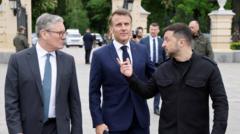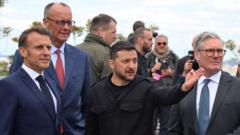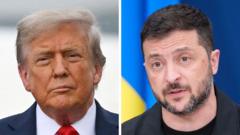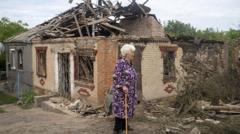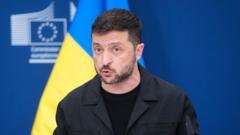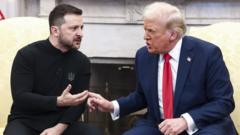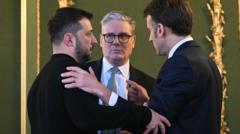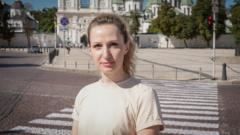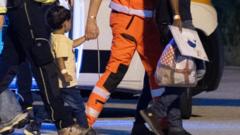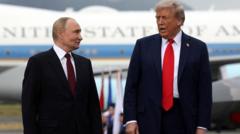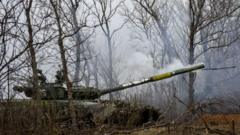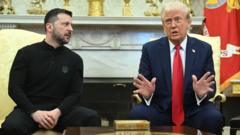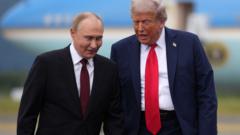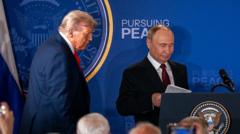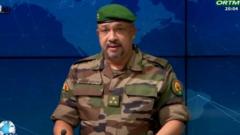In the ongoing conflict since Russia's full-scale invasion, Ukrainian photojournalists have turned their lenses from capturing joyous moments to unraveling the profound tragedies and fleeting joys of those affected by war. Their stories document not only loss, but also the powerful resilience of the human spirit amidst ongoing violence.
Witnessing the Unseen: Photojournalists Unravel the Human Toll of the Ukraine War
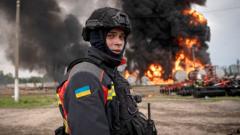
Witnessing the Unseen: Photojournalists Unravel the Human Toll of the Ukraine War
Ukrainian photojournalists provide a harrowing glimpse into the emotional and physical impact of war, capturing moments of despair and resilience.
In the three years since Russia began its extensive invasion of Ukraine, the landscape of photojournalism has drastically changed. Hundreds of photographers have emerged, devoted to documenting the profound human toll experienced by both military personnel and civilians; their work features prominently in news outlets, including BBC coverage of the conflict.
Former wedding and portrait photographers, Vlada and Kostiantyn Liberov, epitomize this transformation. Residing in Odesa, they recount the harrowing shift in their work from capturing love-filled moments to witnessing and recording acts of violence and sorrow. Vlada's personal experience with danger was evident when shrapnel was left lodged in her side after an explosion while covering the Donetsk region. She reflected on the emotional scars that linger: "It's not something we talk about a lot with colleagues as it's painful. You are in a very hard situation, and no-one quite understands what the solution can be."
A powerful image from Kostiantyn during the 2024 summer offensive in Kursk encapsulated the relentless emotional strain on soldiers, portraying a grieving comrade mourning a fallen friend. The loss of life, especially during missions inside Russia, raised painful questions about identity and duty, as noted by Kostiantyn: "It says a lot about the situation and how hard it was for them."
Among the narratives shared, Valeria Demenko's work has centered on the Ukrainian emergency services in Sumy, chronicling their brave responses to Russian attacks. In one unforgettable moment captured in March 2024, the wreckage of a residential building devastated by shelling starkly illustrated the stakes of her documentation. "There was a doll on one of the upper floors... it meant a child was living there," she recalled, haunted by the uncertainty of survival for those unaccounted for.
Alexander Ermochenko, with over a decade of experience in capturing the realities of war, emphasizes the shared human experience across frontlines, stating, “The fear on the face of the owner of a destroyed house is the same on both sides of the front.” His work conveys an unfiltered view of destruction amid daily life, stressing that “blood has the same red color.”
Kyiv-based photojournalist Alina Smutko expresses her commitment to documenting the impact of the war, accentuated by her personal encounters with missile attacks. She reflects on the loss suffered by many in her profession and the necessity of her role: “If something hasn't been photographed, it hasn't happened.”
In this ongoing saga of love, loss, and resilience, these photojournalists sift through the pain and chaos of conflict, ensuring that their work captures every last ounce of strength displayed by the human spirit. As they convey these narratives, they remind the world of the profound impacts of conflict, intent on keeping the stories of people alive, even amidst the backdrop of war.
Former wedding and portrait photographers, Vlada and Kostiantyn Liberov, epitomize this transformation. Residing in Odesa, they recount the harrowing shift in their work from capturing love-filled moments to witnessing and recording acts of violence and sorrow. Vlada's personal experience with danger was evident when shrapnel was left lodged in her side after an explosion while covering the Donetsk region. She reflected on the emotional scars that linger: "It's not something we talk about a lot with colleagues as it's painful. You are in a very hard situation, and no-one quite understands what the solution can be."
A powerful image from Kostiantyn during the 2024 summer offensive in Kursk encapsulated the relentless emotional strain on soldiers, portraying a grieving comrade mourning a fallen friend. The loss of life, especially during missions inside Russia, raised painful questions about identity and duty, as noted by Kostiantyn: "It says a lot about the situation and how hard it was for them."
Among the narratives shared, Valeria Demenko's work has centered on the Ukrainian emergency services in Sumy, chronicling their brave responses to Russian attacks. In one unforgettable moment captured in March 2024, the wreckage of a residential building devastated by shelling starkly illustrated the stakes of her documentation. "There was a doll on one of the upper floors... it meant a child was living there," she recalled, haunted by the uncertainty of survival for those unaccounted for.
Alexander Ermochenko, with over a decade of experience in capturing the realities of war, emphasizes the shared human experience across frontlines, stating, “The fear on the face of the owner of a destroyed house is the same on both sides of the front.” His work conveys an unfiltered view of destruction amid daily life, stressing that “blood has the same red color.”
Kyiv-based photojournalist Alina Smutko expresses her commitment to documenting the impact of the war, accentuated by her personal encounters with missile attacks. She reflects on the loss suffered by many in her profession and the necessity of her role: “If something hasn't been photographed, it hasn't happened.”
In this ongoing saga of love, loss, and resilience, these photojournalists sift through the pain and chaos of conflict, ensuring that their work captures every last ounce of strength displayed by the human spirit. As they convey these narratives, they remind the world of the profound impacts of conflict, intent on keeping the stories of people alive, even amidst the backdrop of war.

